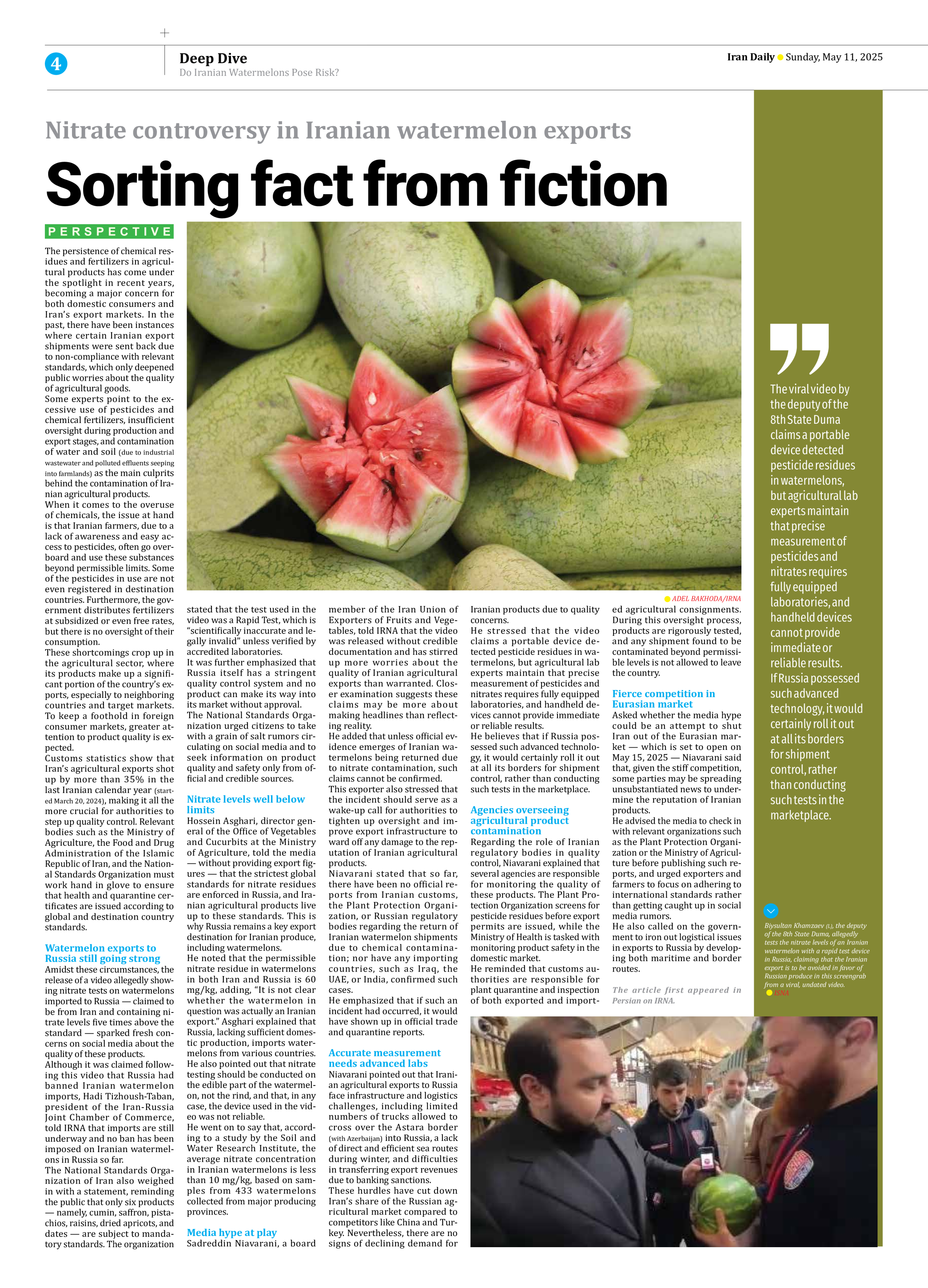
Nitrate controversy in Iranian watermelon exports
Sorting fact from fiction
The persistence of chemical residues and fertilizers in agricultural products has come under the spotlight in recent years, becoming a major concern for both domestic consumers and Iran’s export markets. In the past, there have been instances where certain Iranian export shipments were sent back due to non-compliance with relevant standards, which only deepened public worries about the quality of agricultural goods.
Some experts point to the excessive use of pesticides and chemical fertilizers, insufficient oversight during production and export stages, and contamination of water and soil (due to industrial wastewater and polluted effluents seeping into farmlands) as the main culprits behind the contamination of Iranian agricultural products.
When it comes to the overuse of chemicals, the issue at hand is that Iranian farmers, due to a lack of awareness and easy access to pesticides, often go overboard and use these substances beyond permissible limits. Some of the pesticides in use are not even registered in destination countries. Furthermore, the government distributes fertilizers at subsidized or even free rates, but there is no oversight of their consumption.
These shortcomings crop up in the agricultural sector, where its products make up a significant portion of the country’s exports, especially to neighboring countries and target markets. To keep a foothold in foreign consumer markets, greater attention to product quality is expected.
Customs statistics show that Iran’s agricultural exports shot up by more than 35% in the last Iranian calendar year (started March 20, 2024), making it all the more crucial for authorities to step up quality control. Relevant bodies such as the Ministry of Agriculture, the Food and Drug Administration of the Islamic Republic of Iran, and the National Standards Organization must work hand in glove to ensure that health and quarantine certificates are issued according to global and destination country standards.
Watermelon exports to Russia still going strong
Amidst these circumstances, the release of a video allegedly showing nitrate tests on watermelons imported to Russia — claimed to be from Iran and containing nitrate levels five times above the standard — sparked fresh concerns on social media about the quality of these products.
Although it was claimed following this video that Russia had banned Iranian watermelon imports, Hadi Tizhoush-Taban, president of the Iran-Russia Joint Chamber of Commerce, told IRNA that imports are still underway and no ban has been imposed on Iranian watermelons in Russia so far.
The National Standards Organization of Iran also weighed in with a statement, reminding the public that only six products — namely, cumin, saffron, pistachios, raisins, dried apricots, and dates — are subject to mandatory standards. The organization stated that the test used in the video was a Rapid Test, which is “scientifically inaccurate and legally invalid” unless verified by accredited laboratories.
It was further emphasized that Russia itself has a stringent quality control system and no product can make its way into its market without approval.
The National Standards Organization urged citizens to take with a grain of salt rumors circulating on social media and to seek information on product quality and safety only from official and credible sources.
Nitrate levels well below limits
Hossein Asghari, director general of the Office of Vegetables and Cucurbits at the Ministry of Agriculture, told the media — without providing export figures — that the strictest global standards for nitrate residues are enforced in Russia, and Iranian agricultural products live up to these standards. This is why Russia remains a key export destination for Iranian produce, including watermelons.
He noted that the permissible nitrate residue in watermelons in both Iran and Russia is 60 mg/kg, adding, “It is not clear whether the watermelon in question was actually an Iranian export.” Asghari explained that Russia, lacking sufficient domestic production, imports watermelons from various countries. He also pointed out that nitrate testing should be conducted on the edible part of the watermelon, not the rind, and that, in any case, the device used in the video was not reliable.
He went on to say that, according to a study by the Soil and Water Research Institute, the average nitrate concentration in Iranian watermelons is less than 10 mg/kg, based on samples from 433 watermelons collected from major producing provinces.
Media hype at play
Sadreddin Niavarani, a board member of the Iran Union of Exporters of Fruits and Vegetables, told IRNA that the video was released without credible documentation and has stirred up more worries about the quality of Iranian agricultural exports than warranted. Closer examination suggests these claims may be more about making headlines than reflecting reality.
He added that unless official evidence emerges of Iranian watermelons being returned due to nitrate contamination, such claims cannot be confirmed.
This exporter also stressed that the incident should serve as a wake-up call for authorities to tighten up oversight and improve export infrastructure to ward off any damage to the reputation of Iranian agricultural products.
Niavarani stated that so far, there have been no official reports from Iranian customs, the Plant Protection Organization, or Russian regulatory bodies regarding the return of Iranian watermelon shipments due to chemical contamination; nor have any importing countries, such as Iraq, the UAE, or India, confirmed such cases.
He emphasized that if such an incident had occurred, it would have shown up in official trade and quarantine reports.
Accurate measurement needs advanced labs
Niavarani pointed out that Iranian agricultural exports to Russia face infrastructure and logistics challenges, including limited numbers of trucks allowed to cross over the Astara border (with Azerbaijan) into Russia, a lack of direct and efficient sea routes during winter, and difficulties in transferring export revenues due to banking sanctions.
These hurdles have cut down Iran’s share of the Russian agricultural market compared to competitors like China and Turkey. Nevertheless, there are no signs of declining demand for Iranian products due to quality concerns.
He stressed that the video claims a portable device detected pesticide residues in watermelons, but agricultural lab experts maintain that precise measurement of pesticides and nitrates requires fully equipped laboratories, and handheld devices cannot provide immediate or reliable results.
He believes that if Russia possessed such advanced technology, it would certainly roll it out at all its borders for shipment control, rather than conducting such tests in the marketplace.
Agencies overseeing agricultural product contamination
Regarding the role of Iranian regulatory bodies in quality control, Niavarani explained that several agencies are responsible for monitoring the quality of these products. The Plant Protection Organization screens for pesticide residues before export permits are issued, while the Ministry of Health is tasked with monitoring product safety in the domestic market.
He reminded that customs authorities are responsible for plant quarantine and inspection of both exported and imported agricultural consignments. During this oversight process, products are rigorously tested, and any shipment found to be contaminated beyond permissible levels is not allowed to leave the country.
Fierce competition in Eurasian market
Asked whether the media hype could be an attempt to shut Iran out of the Eurasian market — which is set to open on May 15, 2025 — Niavarani said that, given the stiff competition, some parties may be spreading unsubstantiated news to undermine the reputation of Iranian products.
He advised the media to check in with relevant organizations such as the Plant Protection Organization or the Ministry of Agriculture before publishing such reports, and urged exporters and farmers to focus on adhering to international standards rather than getting caught up in social media rumors.
He also called on the government to iron out logistical issues in exports to Russia by developing both maritime and border routes.
The article first appeared in
Persian on IRNA.







